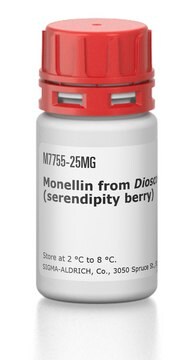P1614
Protein kinase Cζ pseudosubstrate, myristoyl trifluoroacetate salt
≥90% (HPLC)
Synonym(s):
PKC Zeta Pseudosubstrate Inhibitory peptide, ZIP
Sign Into View Organizational & Contract Pricing
All Photos(1)
About This Item
Recommended Products
Quality Level
Assay
≥90% (HPLC)
form
powder
mol wt
calculated mol wt 1928
solubility
H2O: soluble
storage temp.
−20°C
Amino Acid Sequence
Myr-Ser-Ile-Tyr-Arg-Arg-Gly-Ala-Arg--Arg-Trp-Arg-Lys-Leu
Biochem/physiol Actions
Cell permeable protein kinase C (PKC) ζ inhibitor.
Features and Benefits
This compound is featured on the PKC page of the Handbook of Receptor Classification and Signal Transduction. To browse other handbook pages, click here.
Storage Class Code
11 - Combustible Solids
WGK
WGK 3
Flash Point(F)
Not applicable
Flash Point(C)
Not applicable
Personal Protective Equipment
dust mask type N95 (US), Eyeshields, Gloves
Certificates of Analysis (COA)
Search for Certificates of Analysis (COA) by entering the products Lot/Batch Number. Lot and Batch Numbers can be found on a product’s label following the words ‘Lot’ or ‘Batch’.
Already Own This Product?
Find documentation for the products that you have recently purchased in the Document Library.
P M Dang et al.
Journal of immunology (Baltimore, Md. : 1950), 166(2), 1206-1213 (2001-01-06)
Generation of superoxide anion by the multiprotein complex NADPH phagocyte oxidase is accompanied by extensive phosphorylation of its 47-kDa protein component, p47(phox), a major cytosolic component of this oxidase. Protein kinase C zeta (PKC zeta), an atypical PKC isoform expressed
Miguel Salinas-Saavedra et al.
eLife, 7 (2018-08-01)
In triploblastic animals, Par-proteins regulate cell-polarity and adherens junctions of both ectodermal and endodermal epithelia. But, in embryos of the diploblastic cnidarian Nematostella vectensis, Par-proteins are degraded in all cells in the bifunctional gastrodermal epithelium. Using immunohistochemistry, CRISPR/Cas9 mutagenesis, and
Our team of scientists has experience in all areas of research including Life Science, Material Science, Chemical Synthesis, Chromatography, Analytical and many others.
Contact Technical Service

